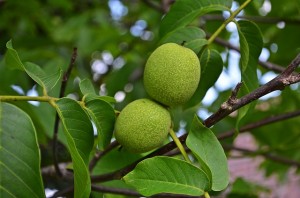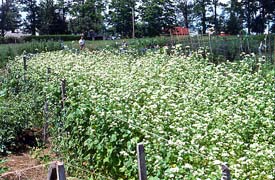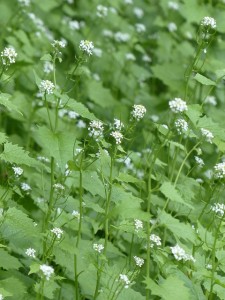You’re prepping your garden for winter, muttering about the sapling black walnut trees the squirrels planted on your behalf mere inches away — and the mother tree is in your neighbor’s yard. You know you can’t put off removing them: this might be the last year your loppers can manage the task.

Black walnuts get a lot of grief from gardeners. For those with small yards and a great love of tomatoes, the black walnut in a neighboring yard is bad news. But for the moment pretend you’ve got couple of acres, mostly meadow. Pretend the mama walnut tree in the hedgerow out back is framed by a couple of invasive ailanthus (aka tree of heaven) and some elderly pines and sugar maples. Pretend also that goldenrod, quackgrass, and garlic mustard are well-established meadow plants that push their way into your garden every chance they get.
And while you’re at it, pretend you planted buckwheat as a cover crop earlier this summer in some beds where weeds have held sway.

What do all these plants have in common?
They’re alleopathic. That is: they have compounds in their leaves, roots, seeds, or stems that stave off other plants. True, some (think garlic mustard) will only hurt you. But some — buckwheat, for instance — will help. (Hint: click on the fifth bullet point when you open the page.)
NYS IPM’s horticulturalist Brian Eshenaur calls such allelopathic compounds “nature’s herbicides.” If you choose and use them, you might avoid the worrisome traits of conventional herbicides.
What worrisome traits? For starters, the potential for weeds to become herbicide-resistant. If using herbicides is the only way you’ve learned to deal with weeds, you could be in trouble. Could weeds (which, like plant diseases, qualify as pests) also become resistant to nature’s herbicides?
No one is sure. The research has just begun. But by way of example, consider this: insect pests become pesticide-resistant with relative ease. On the other hand, they don’t easily outsmart other bugs that evolved to eat them — which is why biocontrol is a key tenet of IPM.

Yes, black walnuts freely release their plant-suppressive chemicals. But even they have their soft spot.
Here’s what black walnuts are willing to live with:
lima, snap and soybeans; beets and swiss chard; corn; onions, garlic and leeks; parsnip and carrots; cauliflower; parsley; Jerusalem artichoke; melons, squash and pumpkins.
And here’s what they aren’t:
asparagus; cabbage, broccoli and kale; eggplant, peppers, potatoes and tomatoes; rhubarb; peas.
Where walnuts crowd too close, build raised beds with root barriers in the bottom — concrete or rubber patio blocks are one option. Hefty tubs are another. You could raise those beds even higher: built at waist height, they could keep your back happy too.
Worried about those walnut leaves that blow into your yard each fall? Can you add them to your compost? Have no fear. Exposed to air, water and bacteria, their toxic effect is history in two to four weeks. [1.]
Want to know more about shrubs and flowers that don’t mind walnut trees? Cornell Cooperative Extension is here to help.
Also, take a look at Eshenaur’s Weed-Suppressive Groundcovers. And consider that most of these plants are great when massed in perennial flowerbeds — and could provide welcome food and shelter for pollinators. Multitasking plants? They’re onto IPM.
- extension.iastate.edu/news/2005/jul/070701; this site also lists some compatible and incompatible plants. ↩